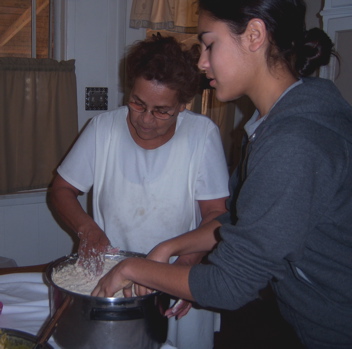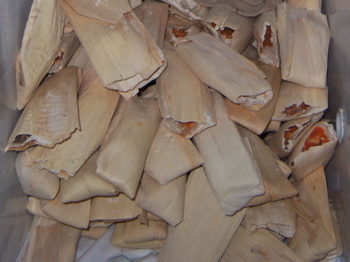Christmas tamales
The tradition of helping her grandma prepare tamales for Christmas dinner is something Breanna, 17, appreciates every year.
My family begins preparing for Christmas at least three weeks in advance because of one thing: tamales. Ever since I can remember, that delectable staple of my Mexican heritage has been the main course of our Christmas dinner. My family members and I have always helped with making them. It’s become a tradition that I look forward to throughout the year.
The person in charge of organizing and cooking the feast is my grandma, Maria Elena. Since she has been making tamales for more than 30 years, you could call her a tamale expert. Three weeks before Christmas she and either my mom or one of my uncles go to the market to buy the ingredients: maza (the dough), cornhusks (for the wrapping), chicken and beef (for the filling), cheese, chile and other “secret” ingredients. We start early because the cornhusks wrappings have to be sorted, washed and dried. About two weeks before Christmas, my family members and I spend a whole week making 150 tamales to feed our family, friends and neighbors.
My grandma makes three types of tamales—red, green and sweet. The first step in making a tamale is preparing the dough and the filling. For the filling, needed for her red and green tamales, my grandma slices the meat and potatoes and places them in a pot on the stove to boil. While the filling is cooking she plops the pre-made dough into a separate pot and begins to “massage” the dough so it is soft enough to mix ingredients into it. After it is soft enough, she adds the spices.
The next step, spreading the dough onto the cornhusks, is where my family and I usually come in. The assembly line begins and we divide ourselves into shifts. On Monday, my Uncle Tony might be in our kitchen spreading a scoop of maza onto the cornhusks and then handing them to my grandma, who adds a layer of the filling. Another relative folds the cornhusks so they enclose the maza and the filling, creating a tamale. The next day, my Uncle Sergio might be wrapping the tamales with butcher paper. If he sees my grandma making the tamales too small, he jokes, “Christmas is a time to be giving, not to be stingy.” Even though it’s hard work I love it because we always manage to have fun as we share stories about the past, talk about how our day is going or listen to my grandma’s favorite radio station, which blares Spanish music.
My grandma’s sweet or dulce tamales are my favorite. Instead of meat and potatoes, we add sugar, cinnamon and her “special ingredients” (which she insists on keeping to herself) to make the maza sweet. I look forward to making them every year. When I’m in the kitchen alone with my grandma I always ask her to tell me about her childhood in Mexico, her family and her life on the ranch. She tells me about her first attempt to make tamales. Though it wasn’t completely a disaster, the maza came out hard and lumpy, “almost like eating rock.” Once my grandma prepares the maza and I spread the sweet dough onto the cornhusks, we roll and tie the ends.
Once all of the maza and filling have been used, my grandma stacks the tamales into the freezer and leaves them in there until Christmas morning. Then she removes the frozen tamales and puts them in a large pot where they steam for about four hours.
On Christmas my house is filled with the delicious aroma of steaming tamales. About 20 of my family members and I begin our Christmas dinner around five and don’t finish eating until ten. By about seven I will have eaten at least five tamales, which is not considered a lot in my family. While we eat, we listen to Christmas carols, look at family pictures, talk and enjoy each other’s company. Alongside the champurrado, a Mexican version of hot chocolate that is slightly thicker and creamier, lemon crème cheesecake and
apple pie, I enjoy eating the tamales because I helped to make that food. When I see the tamales on the plates of our guests, and when I take that first bite and sink my teeth into the steaming maza and juicy meat, I think about the time and effort we all put in. I then realize that my work was well spent.
I help make tamales because I know how much time and effort it takes. Yes, I complain because of the cramps in my hands from kneading the dough or from tying knots in the tamale husks for hours on end. I know that I am doing my grandma a favor and helping to prepare a delicious dinner for my family. More importantly I get to spend time with my family. The cooking and laughing and are at the true meaning of Christmas: surrounding yourself with loved ones.








